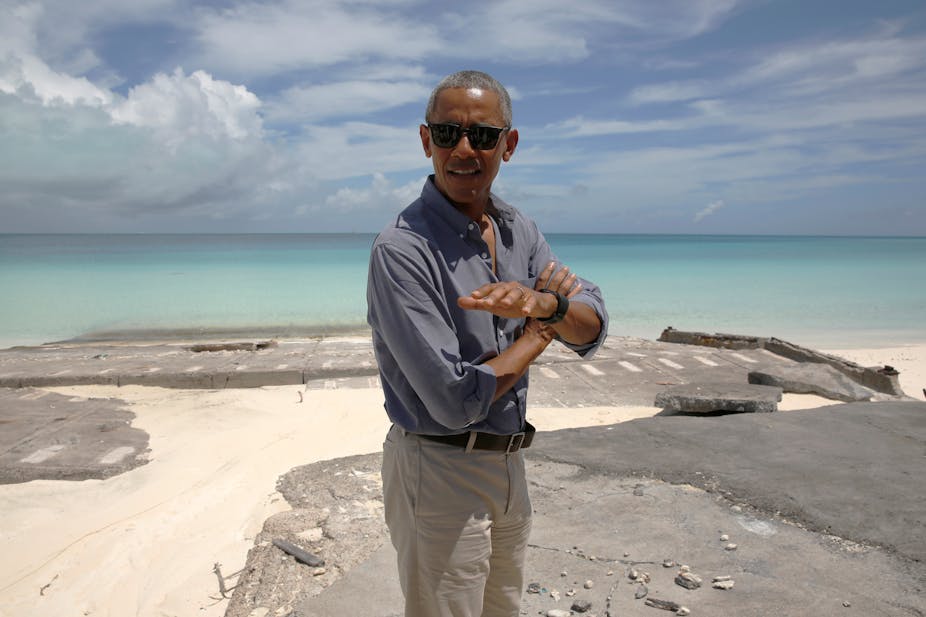During a 2008 town hall event, then Senator Barack Obama told the audience that as a legal scholar and teacher, he took the Constitution “very seriously.” He went on to criticize the Bush administration, asserting:
“The biggest problems that we’re facing right now have to do with George Bush trying to bring more and more power into the executive branch and not go through Congress at all.”
When he was a presidential candidate, it was easy for Obama to criticize the unpopular Bush administration. Once he was in the Oval Office, though, and facing what two congressional scholars call the “uncompromising opposition” of the Republican Party, Obama’s stance on executive power transformed. He realized that, as John F. Kennedy said, “Many things can be done by a stroke of the presidential pen.”
Kennedy was referring to the unilateral powers of the presidency.
Ways to go it alone
Presidents have more than one way to act without the support of Congress and the courts.
These presidential powers include executive orders, proclamations, national security directives and memoranda. The powers matter because many important policies like integrating the military and institutions like the Peace Corps are products of presidents going it alone.
These actions are often controversial because these powers are not part of the Constitution. Although presidents since George Washington have been using unilateral authority, scholars point out that the use of these powers have become more significant under recent presidents. Indeed, University of Chicago scholar William G. Howell argues that the capacity to go it alone is a key characteristic of the modern presidency.
So President Obama is following a rich tradition. As Concordia University professor Graham Dodds writes in his valuable book, “Take Up Your Pen,” Teddy Roosevelt provided the template for the modern president – a model that all of his successors have emulated, regardless of party.
Although he didn’t invent executive power, Roosevelt redefined what could be construed as legitimate. He “established and largely institutionalized the practice of regularly using unilateral presidential directives for significant purposes,” Dodd tells us. Roosevelt issued more than 1,000 executive directives in areas from race relations to simplifying English spelling. Echoing contemporary Republican complaints about President Obama, critics of Roosevelt decried his administration as a “dictatorship” and declared him “Caesar.”

A busy 100 days
For his part, President Obama hit the ground running once in office. According to one report, he issued more unilateral directives “in his first 100 days than any president since Franklin Roosevelt.”
Early in his tenure, Obama issued directives banning torture, made efforts to make his administration more transparent and ordered Guantanamo Bay closed. He also issued a series of pro-labor directives that reversed Bush-era policies.
Throughout his two terms, Obama has implemented major administrative regulations, nearly 50 percent more than President George W. Bush. These include workplace protections, raising the minimum wage for federal employees, extending rights to marginalized groups including an order banning federal contractors from discriminating against LGBT workers and raising fuel efficiency standards. The New York Times recently noted that under Obama’s progressive actions, “the government has literally placed a higher value on human life.”
Despite all of this activity, Obama has also shown some restraint in this polarized political era. Consider executive orders – one of the most frequently used unilateral powers with more than 15,000 issued since the Washington administration. Obama has signed just 33 annually on average, fewer than any president since Grover Cleveland during his first term.
One reason for Obama’s cautiousness may be that presidents are less likely to issue directives during periods of divided government. During Obama’s first term, when he enjoyed unified government during his first two years in office, he averaged 37 executive orders per year. This average dropped to 29 in his second term when Republicans were running Congress.
A team of one
So how effective are these unilateral moves?
Research shows usually quite effective. Congress and the courts have trouble pushing back against presidential directives. However, Obama has been frustrated on a few fronts.
For one, Congress has thwarted Obama’s efforts at tackling gun violence. The president’s lack of progress in this arena demonstrates the limits of a unilateral approach. As Bowdoin professor Andrew Rudalevige tells us, “The most substantive shifts Obama is proposing require legislative approval” – and he didn’t get it. Congress also rejected Obama’s early directive to shut down Guantanamo.
The Supreme Court, for its part, has effectively nullified Obama’s actions on immigration reform and temporarily halted his historic reductions of power plant emissions mandated through the Environmental Protection Agency.

No change ahead
Expect more presidential directives from the next administration. Both Hillary Clinton and Donald Trump have promised, keeping with tradition, to use the unilateral tools while in the White House.
Additionally, if Trump wins, Obama will likely use his powers to implement last-minute agenda items like trade, immigration and health care. A flurry of last-minute orders is typical when the opposing party is taking over the White House.
While his legislative accomplishments like the Affordable Care Act are noteworthy, President Obama’s legacy will be defined in no small part by what he did alone. Obama joins a long line of presidents who were suspicious of these powers before taking office, but who realized the strong appeal of them as a sitting president.
Paul Begala, an adviser to the Clinton administration, put it best, “Stroke of the pen. Law of the land. Kind of cool.”

